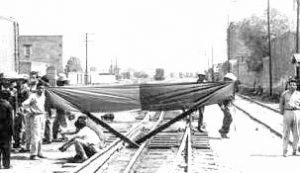Beautiful… But What Is Its Class Outlook?
“My father was in the Mexico student protests,” said a friend in the US. “He heard that ‘Roma’ was about those protests. But he walked out halfway through. He called to tell me not to see it.
“I saw it anyway. It is beautifully done,” the friend continued. “But it has zero content. Absolutely zero.”
‘Roma’ is indeed beautifully done. It’s easy to like for its sympathetic portrayal of a strong indigenous domestic worker. It calls out the racist elitism of her middle-class employers in Mexico City’s Roma neighborhood.
It makes connections between sexism and fascist ideology. While it draws parallels between the impacts of sexism on the main character and her employer, ‘Roma’ emphasizes the deep class divisions between them.
But it’s not true that this movie – or any movie – has “zero content.” Our question should be: What is its class outlook?
‘Roma’ is a fictionalized version of the childhood experiences of the director, Alfonso Cuarón. The main character Cleo is modeled on Liboria “Libo” Rodríguez, who was a live-in servant in the Cuarón home. Cuarón consulted with Ms. Rodríguez to get authentic details of their daily life. But Cleo barely gets to speak. We learn almost nothing about her motivation, her feelings, or her thoughts.
As one critic wrote, the “effacement of Cleo’s character…that burnishes the director’s conscience while smothering her consciousness and his own, is the essential and crucial failure of ‘Roma.’”
But it gets worse. Cleo is portrayed as an unusual, heroic individual. She is cut off from her family. Nowhere is there a hint that she is part of the working class. Or that a working class exists. Or that it has a path to escape capitalist exploitation.
In reality, sharp class struggles rocked Mexico City before and during 1971. Railway workers, bus drivers, garment workers, teachers and others defied trade-union leaders in militant strikes. They were attacked by the same US-trained fascist “Halcones” (Falcons) shown in ‘Roma’ murdering student protesters.
The film reconstructs the Corpus Christi massacre of June 10, 1971, when Los Halcones opened fire on peaceful student protesters. The students had their own demands – not shown in the film – around educational issues and against repression. But many joined the workers’ protests, too—also not shown.
And there is no hint that the massive protests in Mexico were part of an international wave of class struggle that included the Great Proletarian Cultural Revolution in China. Many workers and students were radicalized – including a current leader of the International Communist Workers’ Party. Left-wing groups emerged and grew, such as the September 23 Communist League.
But ‘Roma’ chooses to show instead a fictional “silent nobility of the working poor.” Instead of celebrating the masses in class struggle, it “exalts heroes who do manual labor without having to look closely or deeply at elements of their heroes’ lives that don’t elicit either praise or pity.”
Cuarón chose not to even hint that the working class has the power to liberate itself. Instead he leaves us with images of endless hopeless drudgery. That is its true content.
‘Roma’ is a beautifully-made movie about a working-class heroine that takes the class standpoint of her (and our) oppressors. No wonder that most capitalist critics are raving about it.
We’re not saying “don’t see it.” We’re saying “don’t get sucked in.” We’re saying that if you want to see movies with a working-class outlook, then join the fight for the communist society that will make the lives and the art we need.

Strikers in Ayotla, a community in the city of Ixtapaluca in the state of Mexico, 1966. The strike was provoked by the mass firing of 100 workers. They were organized as an independent union with thousands of supporters. The strike was suppressed by the US-trained fascist “Falcons” and federal troops. But a wave of mass worker protests across the state of Mexico soon followed.

